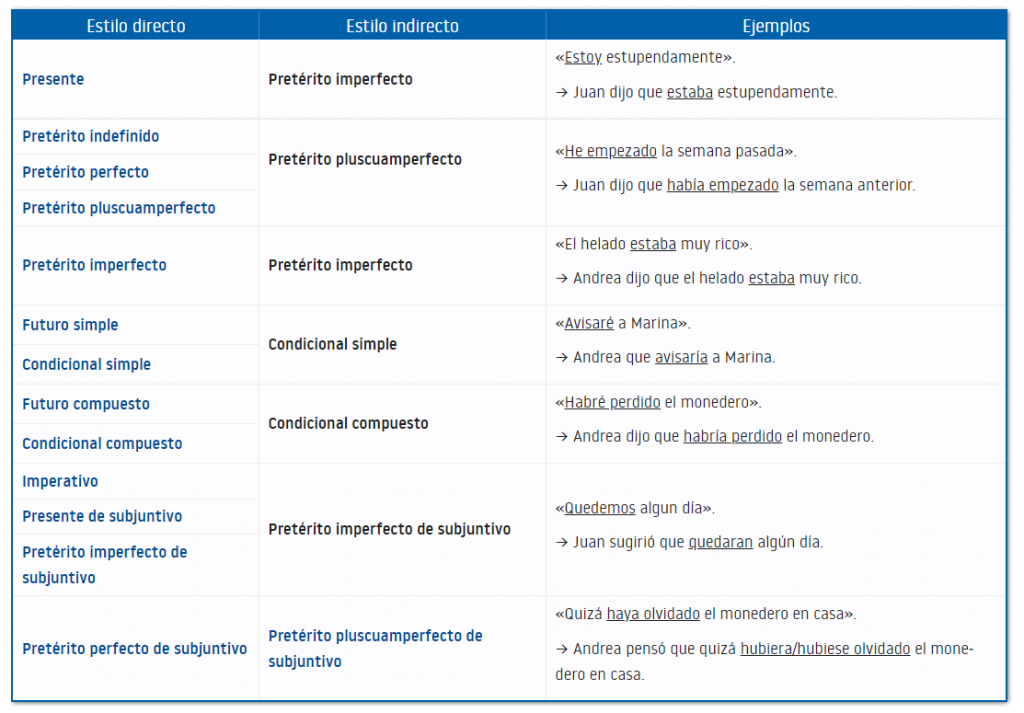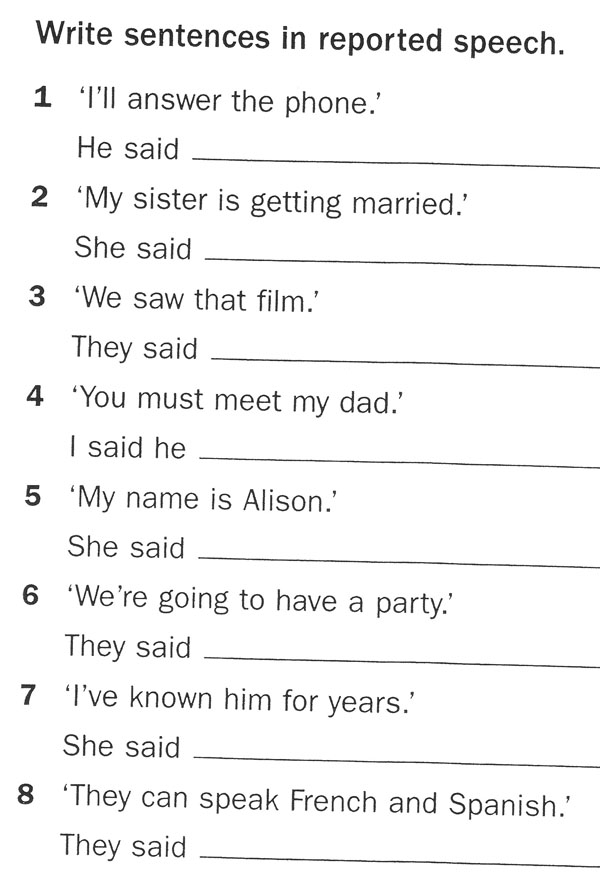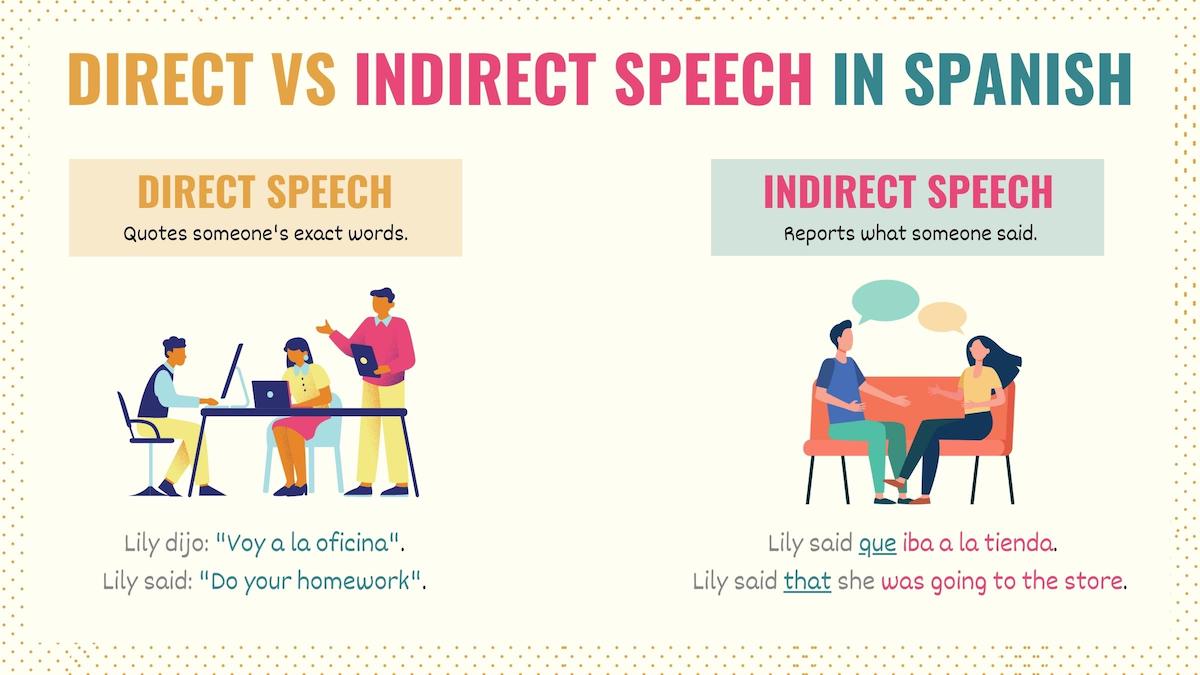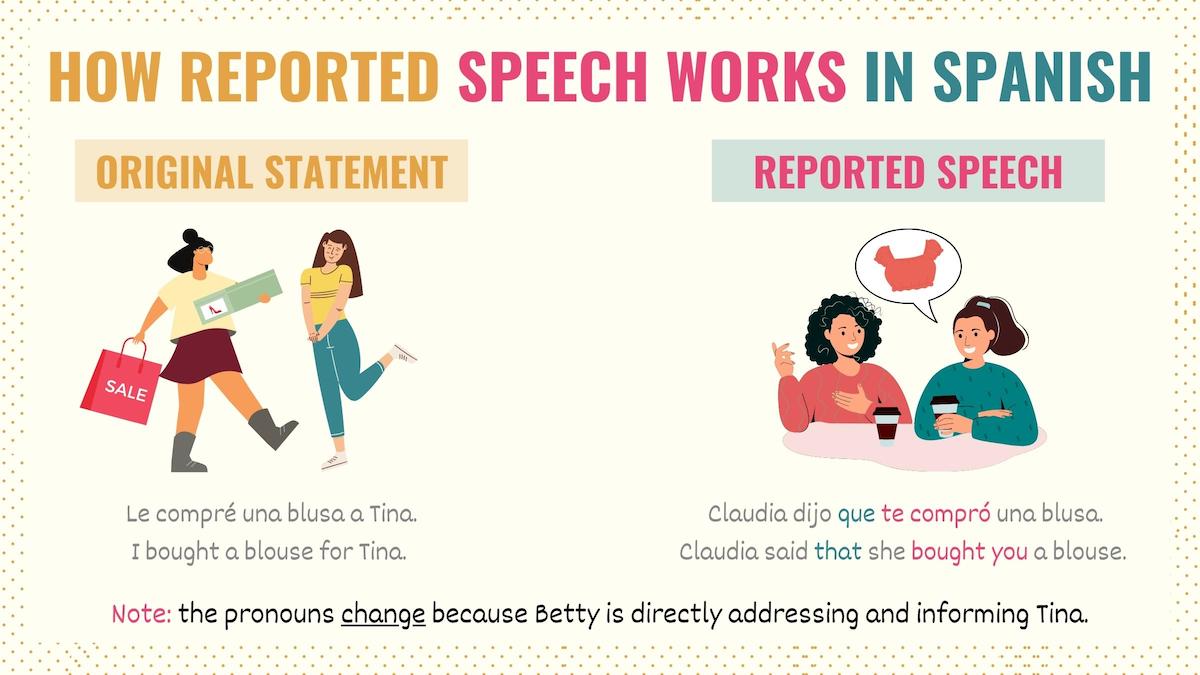Reported Speech (STATEMENTS) explicacion en español YouTube

Spanish Reported Speech How to an Expert LangBox
Indirect or reported speech Written by qualified Spanish expert Inma Sánchez BA Last updated: 2022-12-19 In Spanish and English, when we speak we can use our own words directly, employing direct speech. The exact words of the original speaker are reported in quotes. For example: Pablo dice: "Quiero una moto." - Pablo says: "I want a motorbike."

Reported Speech Spanish Explanation. PDF Oración (Lingüística) Verbo
Reported speech, also known as indirect discourse, is the reproduction or "repackaging" of someone else's message. In English and in Spanish, we normally begin reported speech with a reporting verb ( dijo ("he/she said") ), preguntó ("he/she asked"), etc.), followed by a conjunction ( que ("that")) and then the message.

Reported Speech Spanish Unit Bundle Teaching Resources
We use the reported speech when we want to say what other people say, think or believe. There are two ways of report this information: Direct speech: when we transmit the original message word for word. We introduce the information with an introductory verb followed by inverted commas. Example: The president said: "Yes we can."

Reported Speech in Spanish Spanish Via Skype
If you you want to report either a command, a statement, or a question in Spanish, you need to use a simple formula: Subject + Verb + Object El maestro quiere que Miguel (subject) repita (verb) el examen (object). The teacher wants Miguel to repeat the exam. Mamá dijo que Carlos (subject) podía (verb) venir (object) .

Reported Speech Spanish ReadingConversationWriting Worksheets Teaching Resources
Reported Speech in Spanish (B1) Reported speech or indirect speech -EL ESTILO INDIRECTO in Spanish- are used to relate someone's words without using a direct quote. Expressing "Say" Decir without an indirect object usually means "to say."

Reported Speech in Spanish More Changes Spanish Via Skype
Reported speech in Spanish is a concept that linguists use to explain how speakers interpret another person's words. So, when you need to recount a past conversation, you can use this way of interpreting it. What does this imply?

Reported Speech Spanish Multiple Choice Exam Amped Up Learning
Reported speech, also known as indirect speech, is an essential aspect of Spanish grammar that allows us to convey information or reproduce someone else's words in a different context. In this article, we will explore the concept of reported speech in Spanish, its usage, and provide examples to help you practice and improve your understanding.

Reported Speech Spanish Exercises avockrey
Reported speech or indirect speech (el estilo indirecto) is when we repeat what another person has said without directly quoting it. This means that we often have to adapt or change certain parts of speech such as pronouns, tenses and time and place markers to reflect that we are only reporting what was said, not repeating it word-for-word.

Reported Speech Interactive Spanish Combo WorksheetGoogle Apps Teaching Resources
What Is the Reported Speech in Spanish? Reported speech in Spanish, also known as indirect speech, conveys what someone else said without quoting their exact words. Simply put, Spanish indirect speech allows you to rephrase and report what someone said. On the contrary, direct speech involves quoting the exact words a person used. For instance:

Reported Speech (STATEMENTS) explicacion en español YouTube
The difference between direct and indirect speech (also called reported speech) is pretty easy to understand. But it's not very easy to apply when speaking in a foreign language. It is a very important part of communicating, however, and plays an major role in most conversations.

Reported Speech Spanish Guide Examples + Verb Changes
Corporate English Reported speech in Spanish is when you relay what someone else has said. Learn how to use it and increase your conversation abilities today.

Reported Speech Spanish Guide Examples + Verb Changes
Reported speech in Spanish ( estilo indirecto) is a concept that linguists use to explain how the speakers interpret another person's words. Spaniards love cotilleos (rumors), knowing about our neighbors' lives or telling secrets. Well, when you need to tell a past conversation, you can use the reported speech in Spanish.

Reported Speech Spanish Word Search Worksheet Amped Up Learning
As in English, there are two ways to report the declaration of someone else in Spanish: direct way and indirect way. The first one is called the direct speech and the latter is called the indirect speech or the reported speech. Governing the reported speech is of course more complicated than governing the direct speech.

reported speech en español explicacion YouTube
Reported speech in past tense: Ella dijo que tenía frío. She said she was cold. As you can see, when we report speech in the present tense using "dice que." the tense used in the reported speech remains the same. However, if we report speech in the past tense using "dijo que." the tense changes: tengo → tenía / am → was) - note that.

Reported Speech in Spanish (Avancemos III 52 Gittings) YouTube
Intermediate theory video lesson 24. 1. Let´s start by making some sentences using Spanish reported speech. I will tell you some sentences and I would like you to transform them to reported speech using "Dijo que". For example, if I say "Hace mucho calor" you should say "Dijo que hacía mucho calor": Tengo frío. He terminado de.

Reported Speech Spanish PowerPoint Presentation Teaching Resources
Reported Speech in Spanish: Master the Art of Talking About What Other People Say Reported speech is everywhere. In English, you use it dozens (if not hundreds) of times every day without even realizing it. The good news is that you can be that natural in Spanish, too.